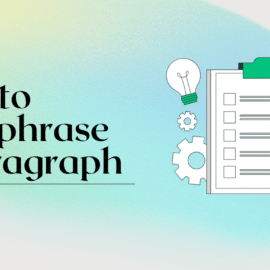
Plagiarism happens when we take someone’s words or thoughts without giving them credit. Sometimes, people do it on purpose, but many times it’s because they forget or don’t realize. When you’re working on a school paper or a project, you’re using what others have already written to support your own ideas. To avoid plagiarism, you need to make sure you use their words correctly and give them credit.
Plagiarism is like a puzzle with different pieces, all related to how we use others’ work in our own writing. It can be as simple as copying someone else’s words directly or changing a few words to make it look different. However, these actions go against being fair and honest in our work.
Why is it Important to Avoid Plagiarism?
Plagiarism isn’t just something for schools to worry about – it happens in workplaces and other places too. Imagine you created something cool, like a drawing or a story. Now, think if someone else took your creation, didn’t say you made it, and showed it to others as their own. That’s like taking away the credit and the fun from what you did.
This problem isn’t just about rules; it’s about making sure we’re respectful and honest when we use ideas from others. Imagine a big group of people all sharing their ideas and thoughts. If someone takes an idea and pretends it’s theirs, it’s like making the group less happy and less creative.
Plagiarism isn’t a good thing for our community of learners. It’s important that we give credit to others for their work, just like we would want credit for our own work. This way, we all keep learning from each other and creating awesome things together.
5 Tips to Avoid Plagiarism
These 5 straightforward techniques will help you avoid plagiarism in your writing.
1. Citing Sources: Giving Credit Where It’s Due
When we write stuff, it’s like a big puzzle made of ideas. Sometimes, we use other people’s ideas to make our puzzle complete. But here’s the thing: To avoid plagiarism we need to give credit to those folks whose ideas we use. That’s where citing sources comes in.
What’s Citing?
Citing is like saying, “Hey, this cool idea isn’t mine. It belongs to this person.” Imagine you’re making a yummy sandwich using a secret sauce recipe from your friend. You don’t want people to think you invented that sauce, right? So, you tell everyone, “My friend Sarah’s the sauce genius behind this!”
Why Do We Cite?
First, it’s about fairness. When you share someone’s idea, it’s like being a good friend and letting them join your puzzle. Second, it’s about trust. When you say where an idea came from, people know you did your homework and aren’t just making things up.
How to Do It?
It’s not tricky at all! Just follow these steps:
- Find the Right Words: When you use someone’s idea, put their name and where you found it. For example, “According to a study by Dr. Smith…”
- List the Details: At the end of your writing, make a list of all the sources you used. This is your “References” or “Works Cited” list. Put the author’s name, the title of the thing you used, where you found it, and the date. Like this:
- Smith, J. (Year). The Wonderful World of Ideas. Cool Publishing.
- Use Styles: Sometimes, teachers or bosses want things to look a certain way. They might ask for APA, MLA, or Chicago style. It’s like a fancy outfit for your sources list. There are tools that can help you with this, so you don’t have to do it all by yourself.
Remember, citing sources isn’t a boring rule. It’s a way of celebrating other people’s cool ideas and showing you’re a responsible writer who plays fair. So, next time you borrow an idea for your puzzle, give a little nod to the puzzle piece’s real owner!
2. Summarize: Making Big Ideas Short and Sweet
Imagine you have a big, juicy burger. But sometimes, you just want a taste of it, not the whole thing. That’s where summarizing comes in – it’s like taking a big idea and making it small, but still delicious! To learn more, check our examples of summarizing
What’s Summarizing?
Summarizing is like telling a friend about a cool movie you watched, but you don’t give away all the details. You pick the main parts, the exciting stuff, and share that. It’s similar to offering a glimpse without revealing the entire movie.
Why Do We Summarize?
We summarize to save time and share the important stuff. Think about a long book – reading the whole thing takes a while. But if someone tells you the main plot in a few sentences, you get the idea faster.
How to Do It?
Here’s the fun part – summarizing is easy:
- Pick the Main Stuff: Read the big thing you want to summarize. Pick out the main ideas, like the most important parts of your burger.
- Use Your Own Words: Now, put the big ideas in your own words. Pretend you’re telling your friend about the movie using simple words.
- Leave Out Details: Remember, you’re not telling the whole story. Skip the small details that aren’t super important.
- Keep It Short: Summaries are like mini-stories. They’re shorter but still exciting. Aim for a few sentences, not a whole page.
Summarizing helps people understand things quickly. Teachers do it when they explain lessons in class. It’s like a shortcut to the good parts of a story or an article.
So, next time you’re reading something big, try summarizing it. It’s like sharing a delicious bite of your burger with a friend – they’ll get the taste without eating the whole thing!
3. Use Rewording Tools
Remember playing with building blocks? Rewording is like that, but with words! It involves taking someone else’s words and crafting something new, all while maintaining the original meaning. Essentially, it’s about making something your own while staying true to the original idea.
Rewording with synonyms isn’t just a creative exercise; it’s a gesture of respect. By choosing to rephrase, you demonstrate understanding and give credit to the original thinker.
How to Rock at Rewording
Ready to become a word artist? Follow these steps:
- Understand the Idea: Read the original sentence or paragraph. Make sure you get what it’s saying.
- Put It in Your Words: Now, imagine you’re explaining the idea to a friend who hasn’t heard it before. Use your own words, but keep the main point.
- Mix It Up: Change some words, like using synonyms (words that mean the same thing) or reordering the sentence. But remember, the meaning should stay the same.
- Check It: After you reword, read it again. Does it still make sense? Does it capture the original idea?
4. Use Plagiarism Prevention Software
Plagiarism checker tools check your work against databases to find any similar parts. If you find anything that looks the same, change it before you hand in your work. These tools use advanced algorithms to even find things that are a little bit the same.
5. Quotation: Borrowing Words with Respect
Ever heard someone say something super cool, and you wanted to share it exactly as they said it? Quotation is your ticket to do just that! It’s like borrowing someone’s words for a bit, but you promise to give them back. Still confused? Read this article to learn when to quote
What’s Quotation?
Imagine your friend says, “Life is like a roller coaster, full of ups and downs.” You love that saying and want to tell others. Quotation lets you use those exact words and gives credit to your friend. It’s like borrowing their voice for a moment.
Why Use Quotation?
Using quotations is much like giving someone a shout-out. When you use quotation marks around words, you’re saying, “Hey, these words belong to someone else.” It’s a way to be super honest about who said what.
How to Do It Right
Using quotation to avoid plagiarism is easy-peasy. Just follow these steps:
- Copy the Exact Words: When you want to use someone’s words, copy them exactly as they said. Don’t change anything!
- Add Quotation Marks: Put quotation marks (” “) at the beginning and end of the words you borrowed.
- Say Who Said It: After the quotation, say who said those words and where you found them. It’s like introducing your friend to everyone.
A Quick Note on Long Quotes
If the quote is longer, you can put it in its own paragraph. But still, keep those quotation marks to show it’s not your words.
Why It’s Awesome
Quotation is your VIP pass to use awesome words from others. It’s like having a guest speaker at your writing party. And just like how you’d thank a guest speaker, you’re thanking the person whose words you used.
The Role of Proper Referencing Styles in Preventing Plagiarism
Knowing how to use the right referencing styles is really important when you’re doing academic or professional writing. Styles like APA, MLA, and Chicago give you clear rules that go beyond just how things look.
These styles are like important tools. They help you prevent plagiarism and present your work in a consistent way and make it clear where your ideas come from.
For instance, the American Psychological Association (APA) style is widely used in social sciences, psychology, and education. It dictates the organization of references, in-text citations, and even the structure of the paper, ensuring a cohesive and easily navigable document. Similarly, the Modern Language Association (MLA) style is prominent in humanities disciplines like literature and art. It emphasizes concise citations, enabling readers to swiftly locate cited sources in the Works Cited section. On the other hand, the Chicago Manual of Style, known for its versatility, is prevalent across academic fields. Its author-date and notes-bibliography systems provide options to suit different forms of research.
These referencing styles are not just about rules; they are roadmaps that lead readers directly to the origins of your ideas. By adhering to these styles, you not only avoid plagiarism but also reinforce the foundation of your arguments and establish your credibility as a conscientious and responsible researcher or writer.
How to Create Unique Content without Resorting to Plagiarism
Writing from Personal Knowledge and Experience: Infuse your writing with your unique perspective, knowledge, and experiences. Your individuality is a wellspring of authenticity that sets your work apart.
Conducting Thorough Research: In-depth research equips you with a solid foundation to craft original content. Engage with primary sources, critically analyze existing work, and synthesize information to present novel insights.
Expressing Original Ideas: Innovation springs from the exploration of new ideas. Instead of regurgitating existing concepts, strive to introduce fresh perspectives, theories, or interpretations, enriching the discourse within your field.
For more insights into the importance of paraphrasing and expressing original ideas, you can refer to our articles on Why Paraphrasing is Important.
The Importance of Reviewing Your Work Before Submission to Ensure a Completely Plagiarism-Free Piece
Make sure your work is unique from start to finish. When you’re almost done writing, take your time to look for any issues. This step is about more than just fixing grammar. It’s about making sure your work is truly yours.
Read what you’ve written and see if any parts sound like something else you’ve read. If they do, you can use techniques like reverse outlining. Also, compare parts of your work with your research notes. This helps you find any problems and fix them.
Use plagiarism checker tool – These tools look at your work and find any sentences that are too similar to other writing. It’s like having an extra set of eyes.
Remember, the goal of this checking is to prevent plagiarism and keep your work from looking like someone else’s. By doing this, you show that your work is truly yours. This helps you be honest and professional in what you create.
Conclusion
The journey to avoiding plagiarism is one of dedication to originality, respect for intellectual contributions, and a commitment to ethical writing practices. By understanding the diverse forms of plagiarism, embracing effective strategies, and leveraging online tools, you set a course towards producing work that reflects your creativity and integrity. As writers and knowledge seekers, you hold the torch of innovation, illuminating the path towards a future where intellectual honesty prevails.
Other Helpful Resources
- What is the best way to rewrite the sentence to avoid repetition?
- How to paraphrase a paragraph without plagiarizing?
- What are the types of paraphrasing?


